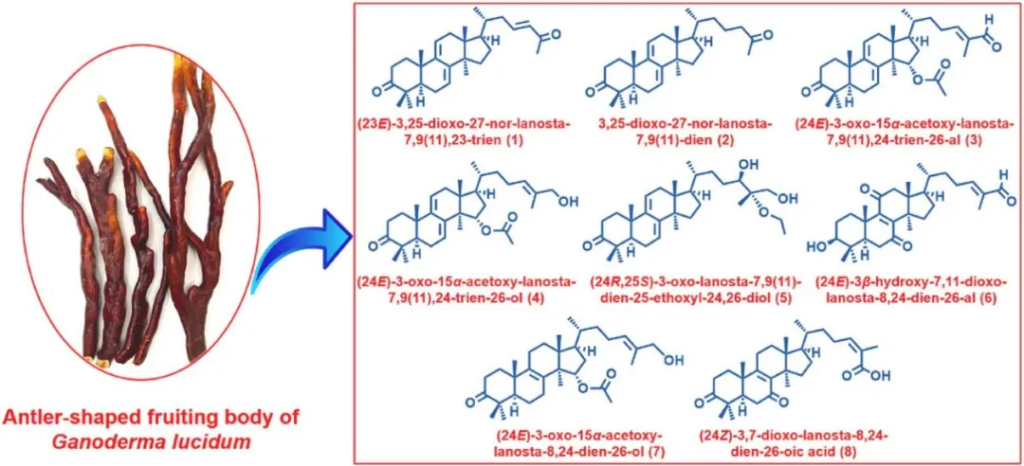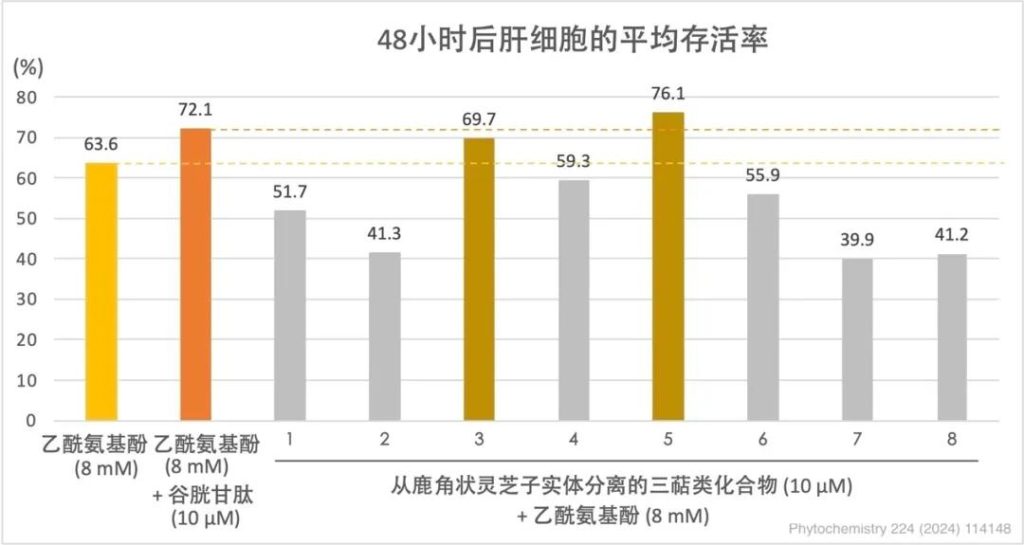
The morphology of the Reishi fruiting body (including the stipe and pileus) and its active ingredients can vary depending on cultivation conditions such as temperature, humidité, light, and ventilation (air circulation). When the carbon dioxide concentration in the environment exceeds a certain level, the Reishi fruiting body will not differentiate into a pileus but will instead extend the stipe, which may also branch during the extension process, resulting in a form resembling antlers. This phenomenon gives rise to the terms “antler-shaped Reishi” ou “antler Reishi.”
Donc, “antler-shaped Reishi” is not a unique variety of Reishi but rather a specific morphological form of the Reishi fruiting body developed under particular environmental conditions. Since the active ingredients in the Reishi fruiting body are the result of continuous interaction with the environment throughout its growth, theoretically, even if the source is the same Reishi variety, the active ingredients in “antler-shaped Reishi” should differ from those in the “Ruyi-shaped Reishi” with a fully developed pileus.
En mai 18, 2024, Senior Researcher Ruoyun Chen and Associate Researcher Jie Kang, from the Institute of Materia Medica, Académie chinoise des sciences médicales, and the State Key Laboratory of Bioactive Substance and Function of Natural Medicines, along with others, published a report online in Phytochemistry (the official journal of the European, North American, and Asian Phytochemical Societies) that confirmed this argument.

(https://doi.org/10.1016/j.phytochem.2024.114148)
Antler-shaped Reishi contains triterpenes that are absent in Ruyi-shaped Reishi.
The report points out that, although nearly 500 triterpenes from Reishi have been publicly documented, their team still managed to isolate seven previously unknown triterpenes (compounds 1–7 in the figure below) from the ethanol extract of antler-shaped Reishi (Ganoderma lucidum) fruiting bodies provided by Fujian Xianzhilou Biological Science and Technology Co., Ltd. in Fujian, as well as one triterpene (compound 8 in the figure below) whose chemical structure matches that of a synthetically produced Reishi triterpene.

Eight triterpenes isolated from the ethanol extract of antler-shaped Reishi fruiting bodies.
Some triterpenes from antler-shaped Reishi exhibit hepatoprotective activity.
The researchers further analyzed the hepatoprotective activity of these eight Reishi triterpenes by adding them (as the experimental group) or glutathione (GSH, known for its antioxidant properties, as the positive control group) along with acetaminophen to human liver cells (HepG2) pour 48 hours of culturing.
Acetaminophen, the active ingredient in paracetamol, is metabolized into oxidative damage-causing metabolites by enzymes in liver cells. Normalement, these metabolites are quickly neutralized into harmless compounds by the antioxidant enzyme glutathione within the cells. Cependant, in cases of acetaminophen overdose, where excessive harmful metabolites are produced, glutathione becomes depleted. The unmetabolized harmful metabolites then undergo oxidative reactions with proteins, lipids, and DNA within the liver cells, leading to damage to the cell membrane, protein dysfunction, and DNA damage, which ultimately results in liver cell death.
De la même manière, liver cells cultured with acetaminophen alone for 48 hours showed a survival rate reduced to 63.6%. Cependant, liver cells protected with glutathione had their survival rate increased to 72.1%. The two newly discovered triterpenes from this experiment (compounds 3 et 5 in the figure above) also exhibited protective effects similar to glutathione, increasing liver cell survival rates to 69.7% et 76.1%, respectivement (comme le montre la figure ci-dessous).

The researchers hypothesize that these two hepatoprotective Reishi triterpenes may protect liver cells from acetaminophen-induced damage through mechanisms such as inhibiting lipid peroxidation, enhancing antioxidant enzyme activity, and suppressing apoptosis. Further experiments are warranted to explore these effects in more detail.
En plus, puisque la lignée cellulaire hépatique humaine HepG2 utilisée dans l'expérience possède des caractéristiques doubles : elle conserve certaines des fonctions normales des cellules hépatiques telles que la détoxification et le métabolisme de l'acétaminophène., tout en présentant également la capacité de prolifération incontrôlée des cellules cancéreuses - des recherches plus approfondies sont nécessaires pour déterminer si les six autres triterpènes Reishi en forme de bois, qui réduisent encore le taux de survie des cellules HepG2, ont des effets inhibiteurs potentiels sur le cancer du foie.
Différents environnements de culture façonnent la morphologie du Reishi et produisent des triterpènes aux structures et activités variées..
Le Reishi est un champignon tout à fait unique. Contrairement à d'autres champignons qui convertissent tous les triterpènes en ergostérol après avoir formé la structure triterpénique initiale. (une structure annulaire pentagonale ou hexagonale composée de 30 carbon atoms) in the fruiting body, Reishi accumulates a large amount of triterpenes and performs extensive modifications such as oxidation, reduction, methylation, ethylation, and shifting of unsaturated bond positions, resulting in a highly diverse range of triterpene configurations.
The above is an explanation by Professor Ching-Hua Su, a Taiwanese scholar specializing in Reishi triterpenes, regarding the diversity of Reishi triterpene compounds. This description should help us understand why Reishi exhibits such varied morphology and characteristics when grown in environments with poor ventilation (high carbon dioxide concentration) versus good ventilation (adequate oxygen).
One reason why Reishi forms and accumulates a variety of triterpenes is likely related to its defense mechanism against surrounding weeds. These triterpenes inhibit certain degradative enzymes, preventing weed germination, while inadvertently providing humans with a range of beneficial physiological functions, such as antimicrobial, antifungal, toxin-degrading, and anti-cancer properties.
Different cultivation conditions give rise to triterpenes with various structures in Reishi, and different chemical configurations produce distinct physiological activities. Whether antler-shaped Reishi triterpenes have advantages over Ruyi-shaped Reishi triterpenes is yet to be explored and developed by scientists.
Regardless of the outcome, this study highlights the importance of cultivation conditions for Reishi. Only by standardizing the cultivation environment after establishing a stable germplasm, and even standardizing the harvest timing, can we consistently produce Reishi materials with specific active ingredients and corresponding health benefits year after year, thereby offering consumers Reishi products that are “as good today as they were yesterday.”
To determine if the Reishi you consume matches the company’s claims, examine whether they follow standardized cultivation practices, which can reveal the truth.
Source: Hongjie Shao, et autres. ‘Triterpenes from antler-shaped fruiting body of Ganoderma lucidum and their hepatoprotective activities.’ Phytochemistry. 2024; 224:114148. est-ce que je: 10.1016/j.phytochem.2024.114148.
FIN

★ Cet article est exclusivement autorisé par l'auteur pour publication, et sa propriété appartient à GanoHerb.
★ Les œuvres ci-dessus ne peuvent pas être reproduites, extrait ou utilisé d'une autre manière sans l'autorisation de GanoHerb.
★ Ceux qui ont été autorisés à utiliser les œuvres doivent les utiliser dans le cadre de l'autorisation et en indiquer la source.: GanoHerbe.
★ GanoHerb poursuivra ses responsabilités légales contre ceux qui violent la déclaration ci-dessus.
★ Le manuscrit original de cet article a été rédigé en chinois par Wu Tingyao et ensuite traduit en anglais par Alfred Liu.. En cas d'incohérences entre la traduction anglaise et le texte chinois d'origine, Ce dernier doit avoir la priorité. Pour toutes les requêtes, Les pls tendent la main à l'auteur d'origine, MS. Wu Tingyao.




